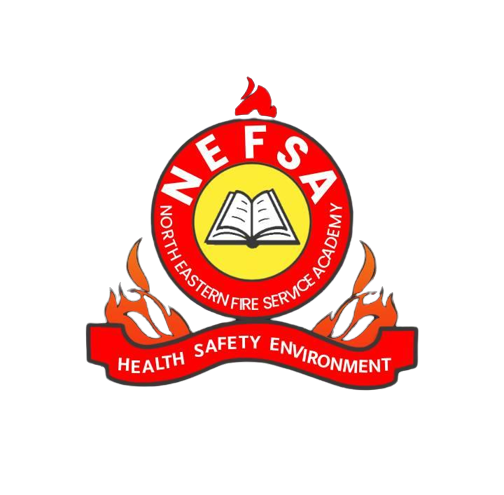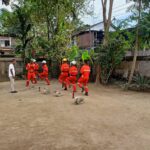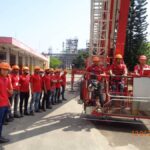Gas cylinder (LPG/propane) fires are dangerous because a continuing fuel source under pressure can rapidly escalate. Fast, informed action saves lives and property but unsafe attempts to “put it out” can make things worse. This NEFSA guide gives practical, research-backed steps for immediate response, short-term control, and prevention.
At a glance — immediate actions (first 60–90 seconds)
-
Raise the alarm & get people out. Evacuate everyone from the room/area and move to a safe distance.
-
Call emergency services. Dial your local fire & rescue number immediately. Tell them it’s a cylinder/LPG incident and give location and number of cylinders if known.
-
Only act if it’s safe. If you can safely reach the cylinder valve without walking through flames or heavy smoke, turn off the valve to stop the fuel. If you cannot reach it safely, do not try withdraw and wait for trained responders.
Why this matters: an open cylinder feeding a flame risks BLEVE (boiling liquid expanding vapour explosion) under extreme heat. Controlling the fuel source is the best way to limit danger — but only attempt valve shutoff if you can do it without exposure to flames or toxic smoke.
Do — short actions if the fire is small and controllable
-
Isolate electricity and ignition sources. Switch off fans, stoves, and electrical appliances from a safe location (do not operate switches in a gas-filled room).
-
Use the right extinguisher: For gas-fed fires a dry powder or CO₂ extinguisher can control flames near the appliance but remember extinguishing visible flame without stopping the leak can cause gas to accumulate and re-ignite. If the leak cannot be stopped, firefighting should be left to professionals.
-
Smother small flame on cooking appliances (not cylinder valve) — e.g., covering a small pan flame with a metal lid but never smother a flame around the cylinder valve itself.
Don’t — common and dangerous mistakes
-
Don’t roll or move a burning cylinder. Moving a heated cylinder risks damaging the valve or dropping it, which is extremely hazardous.
-
Don’t extinguish a flame if you cannot stop the leak. A flame burning at the leak prevents gas buildup; putting the flame out while gas continues to leak can create an explosive gas cloud. Only suppress flames when you’ve stopped the leak or when advised by firefighters.
-
Don’t use water directly on a pressurised cylinder fire to cool the cylinder until firefighters advise uncontrolled water can spread burning gas or make conditions worse if not applied correctly. Professional teams use coordinated cooling techniques to prevent BLEVE.
If someone is burned or inhaled smoke
-
Remove the person from danger, stop burning (smother flames with a blanket if needed), cool burns with running water (20 minutes if possible), cover with clean cloth, and seek medical help immediately. Treat for shock and do not apply oils, creams, or ice. For heavy smoke inhalation, call emergency services and get the victim to fresh air.
Short checklist for homes and small businesses
-
Install and maintain ISI/approved regulators and hoses; replace hoses older than recommended.
-
Keep cylinders upright and ventilated; never store in basements or closed pits.
-
Fit a leak detector or perform soap-solution checks after any cylinder connection change. Never use a naked flame to test for leaks.
-
Store cylinders away from heat sources and direct sunlight; maintain at least 1 m clearance from openings/culverts per local codes.
-
Keep a properly charged dry-powder extinguisher within reach of the kitchen/workshop and know how to use it.
Prevention: training, maintenance & SOPs
-
Training: Regular fire-safety drills and specific cylinder-fire training dramatically reduce panic and errors. NEFSA’s practical courses teach valve isolation, safe extinguisher use, and evacuation drills for industry and households.
-
SOPs & audits: For workplaces, implement written SOPs for cylinder change, leak testing, and emergency response; log maintenance and inspections. Regulatory guidance and industry codes (e.g., NFPA 58 and local LPG regulations) set minimum safe practice standards.
When to leave it to professionals
If the fire involves a large cylinder, multiple cylinders, heavy smoke, or you cannot safely access the valve withdraw and wait for fire & rescue. Inform them of the gas type, cylinder count, and whether any emergency shutoffs were attempted. Professional crews have breathing apparatus, specialized foam/deluge systems, and cooling procedures to safely manage cylinders under fire.
NEFSA recommendation & courses
NEFSA trains individuals and organisations in practical firefighting, cylinder incident response, and disaster management. For workplaces that use LPG or compressed gases, NEFSA recommends:
-
Annual practical drills (valve shutoff, evacuation).
-
At least one trained responder per shift.
-
Regular inspection logs for regulators, hoses, and valves.
Visit NEFSA’s course pages for schedules and tailored corporate training.
Sources (key references)
-
Assam Government — LPG Safety Tips. Fire and Emergency Services Assam
-
British Compressed Gases Association / industry guidance on cylinders in fires. Proactive Gas Safety Training
-
Supergas (LPG safety & leak guidance). Supergas
-
NFPA / International LPG safety guidance (codes & emergency response). worldliquidgas.org+1
-
Sikkim Fire & Emergency Service — LPG fire safety. sikkimfire.nic.in
-
NEFSA — course and training information. nefsaindiablog.com+1
Contact us today to know more about admissions, batch schedules, and course details.
Visit: www.nefsaindia.com
Location: Dibrugarh, Assam
For More Blogs:- Click here







